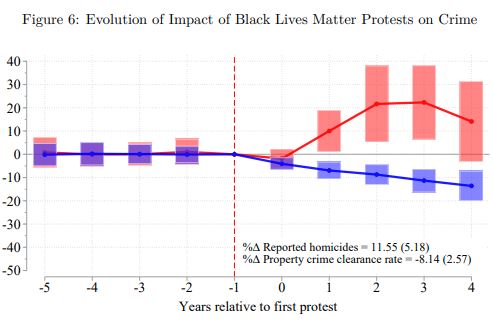Top News
The BLM trade-off: Fewer police killings, more murders

Nearly 2 1/2 years ago Vox published an article about some new research. Though it hadn’t been peer-reviewed at the time, the pre-print paper suggested there might be a trade-off that resulted from Black Lives Matter protests. I wrote about it at the time. Here’s how Vox described it in April 2021:
Travis Campbell, a PhD student in economics at the University of Massachusetts Amherst, released his preliminary findings on the Social Science Research network as a preprint, meaning the study has yet to receive a formal peer review…
From 2014 to 2019, Campbell tracked more than 1,600 BLM protests across the country, largely in bigger cities, with nearly 350,000 protesters. His main finding is a 15 to 20 percent reduction in lethal use of force by police officers — roughly 300 fewer police homicides — in census places that saw BLM protests.
Campbell’s research also indicates that these protests correlate with a 10 percent increase in murders in the areas that saw BLM protests. That means from 2014 to 2019, there were somewhere between 1,000 and 6,000 more homicides than would have been expected if places with protests were on the same trend as places that did not have protests.
Travis Campbell’s study covered the years 2014 to 2019, i.e. it did not include 2020 and the death of George Floyd. Nevertheless, in 2021 Andrew Sullivan argued that it seemed likely the same effect was being seen in 2020 when there was both a reduction in the shooting by police of black men and a big upsurge in shootings and murders nationwide. He asked this question:
…what if the final legacy of Black Lives Matter is that it actually succeeds in its core goal, and that in the future, far fewer African-Americans are shot by the cops. And what if the price of this symbolic victory is, in fact, a huge increase in the numbers of innocent black lives lost to civilian murder?
It took two years but this argument eventually made it to the opinion pages of the NY Times where Thomas Edsall specifically cited Travis Campbell’s work. Well, Campbell’s paper has now been published and there are some changes to his conclusions. [emphasis added]
I examine how BLM protests have changed police behavior, focusing on lethal force. The analysis leverages the occurrence of two major protest waves from 2014 to 2021: the Mike Brown era (2014q3-2015q2) and the George Floyd era (2020q2-2021q4). To conduct this analysis, I create a quarterly panel of 1076 US census places (cities/towns) with at least one BLM protest from 2014 to 2021, merging web-scraped data on BLM protest locations and dates with data on police-involved homicides, crime, and police agency characteristics. To identify the effect of BLM protests on police behavior, I use an event study approach. This approach compares the changes in police behavior between cities that experienced early protests during the Mike Brown era and cities that only witnessed protests during the later George Floyd era. By making this comparison, the study aims to estimate the treatment effect of early BLM protests on police behavior over a five-year period between each protest wave.
The findings of the event study suggest that the BLM protests led police departments to pull back from interactions with the public and obtain body cameras, leading to increased crime and decreased police killings. Specifically, over the five years after local BLM protests, property crime arrests decreased by approximately 12%, while reported murders increased by roughly 11.5%, which is over 3000 additional homicides.
BLM protests also pressured police departments to equip officers with body cameras. Not only did protests lead to over a 14 percentage point increase in the share of agencies obtaining body-worn cameras, but these agencies also cited different motivations for adopting this technology. Rather than focusing on improving evidence quality or reducing agency liability, they reported objectives such as reducing the use of force and enhancing community perception. The combined effect of police pullback and the widespread adoption of body cameras led to a 10% to 15% reduction in lethal force between the end of 2014 and 2019, preventing approximately 200 police killings.
Two things to notice here. First, when Vox initially wrote about this Campbell saw a “15 to 20 percent reduction in lethal use of force by police officers.” In his published paper that has dropped to a 10% to 15% reduction. Instead of saving 300 lives the protests probably saved 200 lives (hat tip to this person on X who highlighted the changes). Here’s a graph from the paper showing the decline:
Second, the 10% increase in murders has been changed to an 11.5% increase in murders. Again, here’s a graph showing that increase (the red line).

As pointed out above, this raises the question of whether BLM has in a very real sense done more harm than good if it’s true that significantly more people (many of them black) died as a result of police pulling back than were saved by police being aggressive.
Much of the paper is about trying to sort out why this is happening and the bottom line seems to suggest a combination of more body cams and the Ferguson Effect, i.e. police pulling back in the wake of public protests. If you’re interested in reading more, the full paper is here.
Read the full article here


















